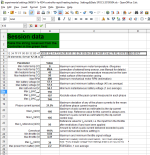After a few hours I went back out, and it had cooled to ambient (which is now 90F).
Turned on battery connect, and switched on SFOC at LED Status panel switch, with no throttle and no phase and no serial connection, just battery power (14s NMC, 57.5v per the CA) and the LED Status panel.
Monitored temperature both by hand (touching the side of the case) and the strapped-on thermal sensor (next to the center heatsink bolt).
Within 15 seconds, it had gone up enough to feel it was warm, to 97F, and continued to rise. I shut power off at that point, not waiting for it to get to ridiculous temperatures, as it indicates there is a problem in the SFOC itself of some type, and is not caused by any attached motor or throttle (or temperature sensor).
While it is possible that damage has occured to the SFOC *from* a motor, that means it is now damaged in a way that causes it to rapidly heat up doing "nothing", it doesn't require that a motor be attached to cause the heating at this point.
I'm going to wait for it to cool down again, and then retest without switching the status panel on, and see what happens. (still not atached to anything but battery and panel)
Then I'm going to reflash to a diferent firmware, and retest (also without connecting anything but batteyr and panel), with and without switching the panel on.
Turned on battery connect, and switched on SFOC at LED Status panel switch, with no throttle and no phase and no serial connection, just battery power (14s NMC, 57.5v per the CA) and the LED Status panel.
Monitored temperature both by hand (touching the side of the case) and the strapped-on thermal sensor (next to the center heatsink bolt).
Within 15 seconds, it had gone up enough to feel it was warm, to 97F, and continued to rise. I shut power off at that point, not waiting for it to get to ridiculous temperatures, as it indicates there is a problem in the SFOC itself of some type, and is not caused by any attached motor or throttle (or temperature sensor).
While it is possible that damage has occured to the SFOC *from* a motor, that means it is now damaged in a way that causes it to rapidly heat up doing "nothing", it doesn't require that a motor be attached to cause the heating at this point.
I'm going to wait for it to cool down again, and then retest without switching the status panel on, and see what happens. (still not atached to anything but battery and panel)
Then I'm going to reflash to a diferent firmware, and retest (also without connecting anything but batteyr and panel), with and without switching the panel on.



